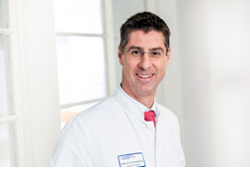State-of-the-art liver tumor surgical method

"In-situ liver splitting" performed successfully on 44-year-old patient / Liver surgery at the Medical Center - University of Freiburg advances further
When the liver is afflicted by tumors, surgical removal is usually the only possible cure. However, liver metastases - provoked for example by colorectal cancer - can be eliminated surgically in only about 20 percent of patients. The new Medical Director of the Department of General and Visceral Surgery, Prof. Dr. Stefan Fichtner-Feigl, has now established a surgical procedure at the Medical Center - University of Freiburg that significantly increases the prospects of success for complete tumor removal. Using the "In-situ liver splitting" method, recently employed in Freiburg for the first time, surgery was successfully performed on a 44-year-old female patient.
"Using this latest form of liver surgery, we were able to help the patient, refute the assessments of many surgeons who had been consulted beforehand, and completely remove the tumor," says Prof. Dr. Fichtner-Feigl. It was the first time this operation was carried out in southern Baden.
The surgical procedure consists of two separate operations. In the first one, the healthy liver tissue is separated from the diseased tissue. The blood supply to the infected area is partly interrupted in this first step, but it remains in the body and continues to fulfill some liver function. During the next seven to ten days the healthy, but actually too small, part of the liver grows to almost twice its previous size. Only then is the diseased part of the liver removed in a second operation. The liver that has regrown from the healthy part can now sufficiently take over all vital functions.
"At the Medical Center - University of Freiburg, we are also now applying three-dimensional computer-controlled surgical planning methods in order to precisely define the positional relationship between individual tumor nodes and important structures such as bile ducts, veins and arteries," adds Prof. Dr. Sven A. Lang, Senior Physician in the Department of General and Visceral Surgery. "This three-dimensional planning can then also be combined with an ultrasound examination during the operation, in order to be able to perform liver surgery as gently but effectively as possible." This technique leads to even safer operations.
In addition to the new surgical techniques and further development of three-dimensional imaging, a novel instrument for measuring liver function is now employed in Freiburg. Determining liver function is a key point in surgical planning and execution. Until now, liver function has only been estimated indirectly during an operation, based on the size of the liver. "The new measuring instrument now available makes it possible to precisely determine liver function and also liver regeneration after the operation," emphasizes Prof. Fichtner-Feigl.
See also:
Back